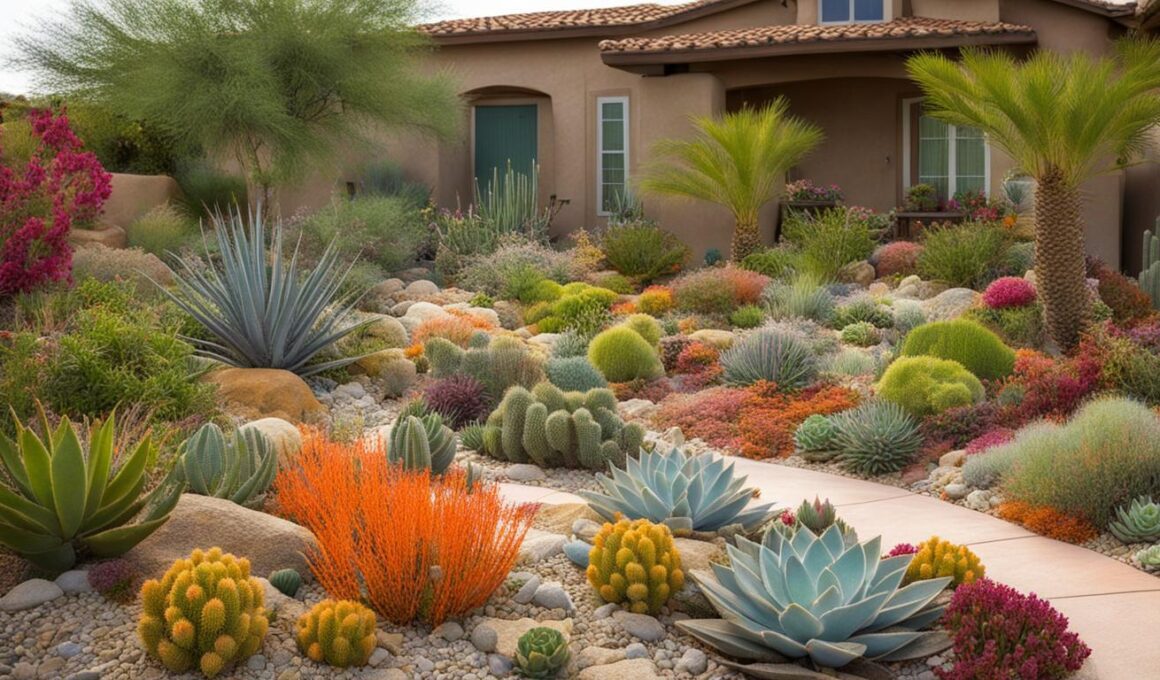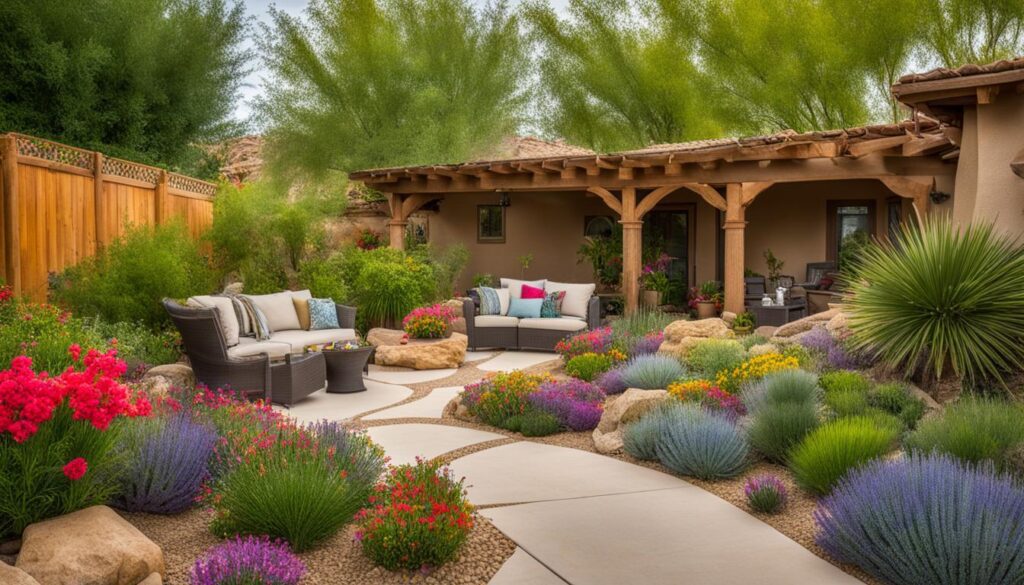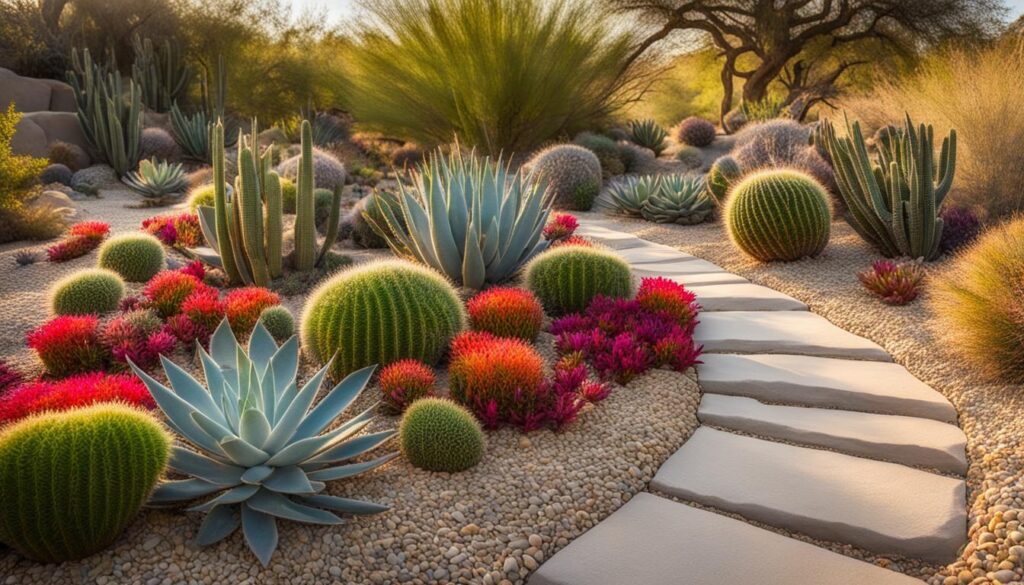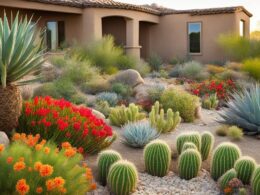Welcome to our guide on xeriscaping, a landscaping technique that focuses on creating beautiful and sustainable outdoor spaces with minimal water usage. If you’re looking to transform your landscape into a drought-tolerant paradise, xeriscaping is the way to go. In this article, we’ll explore the concept of xeriscaping and provide you with ideas to bring year-round visual interest to your outdoor spaces.
Key Takeaways:
- Xeriscaping is a landscaping technique that prioritizes water conservation and sustainability.
- Using native plants, mulch, rocks, and drip irrigation systems are integral to xeriscaping.
- Xeriscaping offers benefits such as water conservation, low maintenance, cost savings, and eco-friendliness.
- Essential elements of xeriscaping include mulch, groundcovers, rock gardens, garden paths, and drought-tolerant plants.
- Design tips for xeriscaping involve incorporating biodiversity, year-round interest, proper soil preparation, a variety of rock materials, and eye-catching elements.
The Benefits of Xeriscaping
Xeriscaping offers numerous benefits that make it an attractive option for homeowners looking to create sustainable and visually appealing landscapes.
Water Conservation
One of the key advantages of xeriscaping is its ability to conserve water. By using native plants that are adapted to the local climate, xeriscaping reduces the need for excessive watering. These plants have evolved to withstand periods of drought, making them more resilient and requiring less maintenance in terms of watering. This not only helps to conserve water resources but also lowers water bills.
Low Maintenance
Xeriscaping is known for its low-maintenance nature. The selection of slow-growing plants that require minimal pruning and trimming means less time spent on upkeep. With xeriscaping, you can enjoy a beautiful landscape without the constant need for mowing, fertilizing, and pest control. This not only saves time but also reduces the use of chemical fertilizers and pesticides, making it an environmentally friendly choice.
Cost Savings
By reducing the water consumption and minimizing the need for regular maintenance, xeriscaping can lead to significant cost savings over time. Water bills can be significantly reduced, especially in areas with high water rates or water scarcity. Additionally, xeriscaping eliminates the need for expensive lawn equipment and reduces the reliance on chemical treatments, resulting in long-term cost savings for homeowners.
Environmentally Friendly
Xeriscaping promotes environmental sustainability by using native plants that require fewer resources. These plants have adapted to the local environment, making them more resistant to pests and diseases. By avoiding the use of chemical fertilizers and pesticides, xeriscaping helps protect waterways and wildlife habitats from harmful runoff. Additionally, the use of mulch and other water-saving techniques reduces soil erosion and helps to maintain healthy soil structure.
Essential Elements of Xeriscaping
When it comes to xeriscaping, there are several essential elements that can help you create a beautiful and sustainable landscape. These elements not only conserve water but also add visual interest to your outdoor spaces. Here are some key components to consider:
Mulch:
One of the essential elements of xeriscaping is the use of mulch. Applying a layer of mulch around your plants and garden beds helps retain moisture in the soil, reduce evaporation, and suppress weed growth. Organic mulches like wood chips or straw work well in xeriscapes, as they break down over time and improve soil fertility.
Groundcovers:
Using groundcovers is another effective way to reduce water usage in xeriscaping. These low-growing plants cover the ground, reducing evaporation and weed growth. Consider using drought-tolerant groundcovers such as creeping thyme or sedum, which can add texture and color to your landscape while requiring minimal maintenance.
Rock Gardens:
Rock gardens are a popular feature in xeriscapes. They not only add visual interest but also help conserve water. By combining rocks of different sizes and shapes with drought-tolerant plants, you can create a striking focal point in your landscape. Rocks also act as a heat sink, absorbing heat during the day and releasing it at night, which benefits your plants.
Garden Paths:
Incorporating garden paths made of permeable materials is important in xeriscaping. These paths allow rainwater to penetrate the soil instead of running off, helping to replenish groundwater reserves. You can line your garden paths with small plants that thrive in moisture, keeping the soil moist and creating a visually appealing pathway through your xeriscape.
Drought-Tolerant Plants:
Choosing the right plants is crucial in xeriscaping. Opt for drought-tolerant plants that can thrive with minimal water. Native plants are often a great choice, as they are well-adapted to the local climate and require less maintenance. Look for plants with low water requirements, such as lavender, yarrow, or succulents, to add color and texture to your xeriscape.
By incorporating these essential elements into your xeriscape, you can create a visually appealing and sustainable landscape that thrives year-round while conserving water. Whether you’re looking to revamp your existing landscape or starting from scratch, xeriscaping provides a practical and environmentally friendly solution for outdoor spaces.
Design Tips for Xeriscaping
Creating an attractive and sustainable xeriscape involves considering several design tips. By incorporating these elements into your landscaping, you can enhance biodiversity, achieve year-round interest, and create a visually appealing outdoor space.
1. Embrace Biodiversity
One key aspect of xeriscaping is promoting biodiversity by selecting a variety of plants. Create a harmonious blend of flowers, shrubs, and trees that thrive in your local climate and soil conditions. By including different species, you can attract a diverse range of wildlife and create a visually stunning landscape.
2. Ensure Year-Round Interest
To maintain visual appeal throughout the seasons, include plants with evergreen foliage or interesting bark in your xeriscape design. These features will provide color and texture even during the colder months. Additionally, consider incorporating flowering plants that bloom at different times throughout the year, ensuring there is always something in bloom.
3. Prepare the Soil
Proper soil preparation is essential for the success of your xeriscape. Loosen compacted soil and add organic matter to improve drainage and water retention. For optimal results, consider incorporating pea gravel into the soil, as it helps with drainage and prevents waterlogging.
4. Use a Variety of Rock Materials
Integrating rocks into your xeriscape design adds texture and visual interest. Choose a variety of rock sizes and shapes to create a dynamic landscape. Large rocks can serve as focal points, while smaller rocks can be used as ground cover or to define garden paths.
5. Incorporate Eye-Catching Elements
To add visual impact to your xeriscape, consider incorporating eye-catching elements such as planters, sculptures, or water features. These elements can serve as focal points and create a sense of balance and harmony in your outdoor space.
How Can Xeriscaping Create Year-Round Visual Interest in a Landscape Design?
Sustainable xeriscaping landscape design techniques can create year-round visual interest by incorporating a variety of drought-tolerant plants, textures, and colors. Utilizing rocks, gravel, and other hardscaping elements can add depth and dimension. Additionally, thoughtful placement of plants can ensure there is always something blooming or providing visual appeal.
Conclusion
Xeriscaping is a sustainable landscaping approach that allows you to create a stunning xeric garden while conserving water and minimizing maintenance. By following the principles of xeriscaping and incorporating elements like mulch, groundcovers, rock gardens, and eye-catching features, you can achieve a visually appealing, water-wise garden that thrives in any season.
Embracing xeriscaping not only benefits the environment but also enhances the beauty and functionality of your outdoor spaces. With a xeric garden, you can enjoy year-round visual interest without compromising on sustainability. By using native plants, reducing water usage, and implementing thoughtful design techniques, you can create a landscape that is both environmentally friendly and visually captivating.
Transform your outdoor space into a sustainable oasis by implementing xeriscaping techniques. With its emphasis on water-wise gardening and sustainable landscaping practices, xeriscaping offers a solution for creating attractive landscapes that require less water and maintenance. Embrace the beauty and practicality of xeriscaping to create a xeric garden that you can enjoy for years to come.












